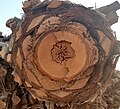
In botany, the trunk (or bole) is the stem and main wooden axis of a tree, which is an important feature in tree identification, and which often differs markedly from the bottom of the trunk to the top, depending on the species.
The trunk is the most important part of the tree for timber production.
Occurrence
Trunks occur both in "true" woody plants and non-woody plants such as palms and other monocots, though the internal physiology is different in each case. In all plants, trunks thicken over time due to the formation of secondary growth, or, in monocots, pseudo-secondary growth. Trunks can be vulnerable to damage, including sunburn.
Vocabulary
Trunks which are cut down for making lumber are generally called logs; if they are cut to a specific length, called bolts. The term "log" is informally used in English to describe any felled trunk not rooted in the ground, whose roots are detached. A stump is the part of a trunk remaining in the ground after the tree has been felled, or the earth-end of an uprooted tree which retains its un-earthed roots.
Structure of the trunk
The trunk consists of five main parts: The outer bark, inner bark (phloem), cambium, sapwood (live xylem), and heartwood (dead xylem). From the outside of the tree working in:
- The first layer is the outer bark; this is the protective outermost layer of the trunk.
- Under this is the inner bark which is called the phloem. The phloem is how the tree transports nutrients from the roots to the shoots and vice versa.
- The next layer is the cambium, a very thin layer of undifferentiated cells that divide to replenish the phloem cells on the outside and the xylem cells to the inside. The cambium contains the growth meristem of the trunk.
- Directly inside of the cambium is the sapwood, or the live xylem cells. These cells transport the water through the tree. The xylem also stores starch inside the tree.
- At the center of the tree is the heartwood. The heartwood is made up of dead xylem cells that have been filled with resins and minerals; these keep other organisms from infecting and growing in the center of the tree.
-
 Raft of timber logs
Raft of timber logs
-
 Cross section of a hazel bole
Cross section of a hazel bole
-
 A de-barked log being decomposed by bracket fungi
A de-barked log being decomposed by bracket fungi
-
 Trunk / stump of a still-rooted olive tree
Trunk / stump of a still-rooted olive tree
-
 Trunk section from a palm tree (the date palm, Phoenix dactylifera).
Trunk section from a palm tree (the date palm, Phoenix dactylifera).
See also
- Basal area – The cross-sectional area of tree stems usually reported as the sum of all trees within a stand on a relative area basisPages displaying wikidata descriptions as a fallback
- Diameter at breast height – Standard method of expressing the diameter of the trunk or bole of a standing tree
- Log (disambiguation)
- Tree measurement
- Tree volume measurement
References
- "trunk". The Free Online Dictionary. Archived from the original on 2011-06-07. Retrieved 2017-02-17.
- War, James. "A tree and its trunk, page 2". dendro.cnre.vt.edu. University of Vermont. Archived from the original on 2018-02-22. Retrieved 2018-02-08.
- Nix, Steve. "Tree Trunk Biology and Basic Wood Structure". ThoughtCo. DotDash. Archived from the original on 1 October 2020. Retrieved 2 August 2020.
External links
 Media related to Tree trunks at Wikimedia Commons
Media related to Tree trunks at Wikimedia Commons- "Inside a tree trunk". wood anatomy. Bellville, South Africa: University of the Western Cape. Archived from the original on 2006-09-23.